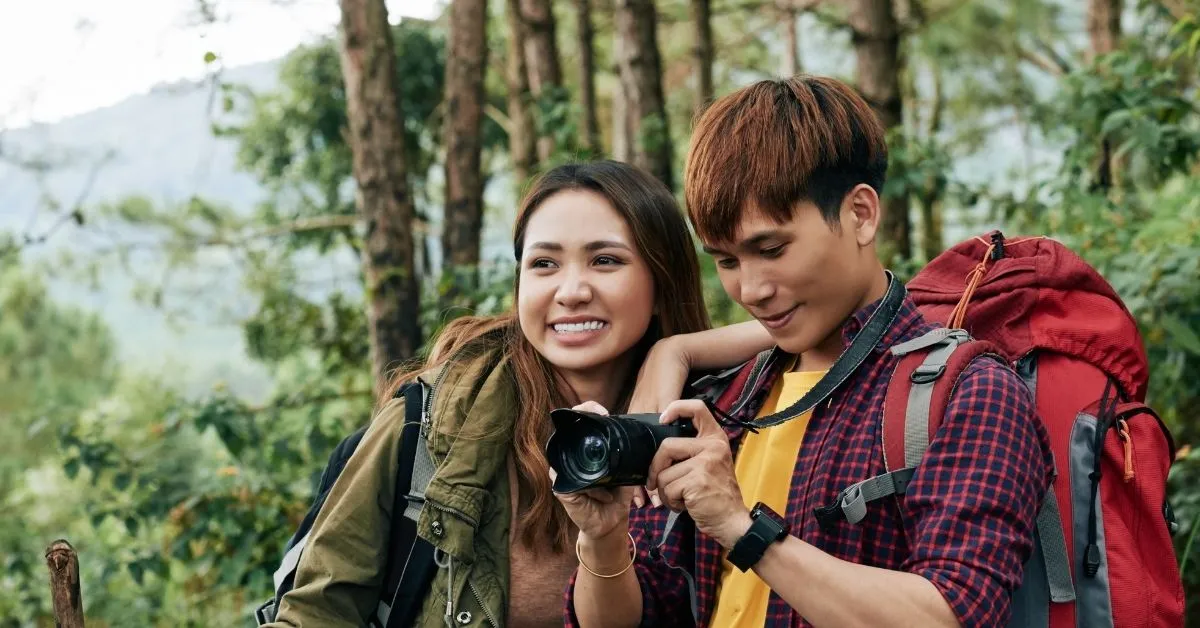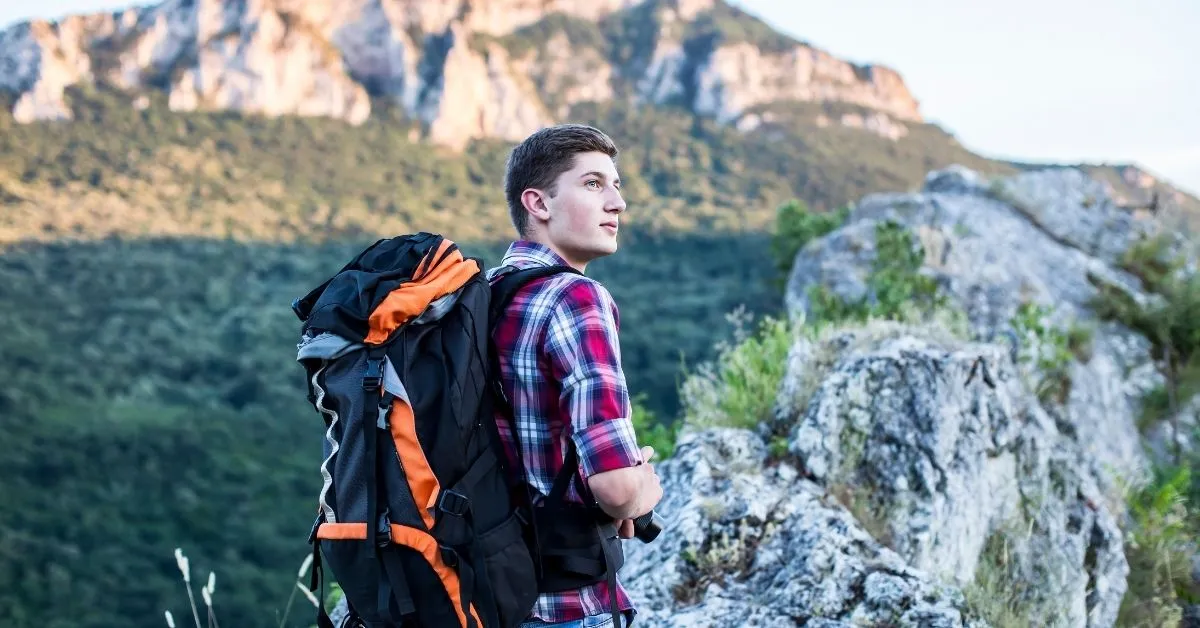How many times have you snapped a gorgeous sunset shot using your smartphone’s camera to find that the photo doesn’t do the view justice?
If you want to accurately reproduce the beauty of the nature and scenery you encounter on your hikes, you’ll need a decent camera. However, while a high-end DSLR camera may produce stunning images, it’s a pain to carry around.
Therefore, how do you determine the best camera for hiking? Read on to find out what to look for in a camera for backpacking and/or hiking. We will then share the best hiking cameras on the market right now for all budgets and abilities.
What To Look For When Buying A Camera For Hiking
Here are some things to look for when buying a camera for hiking and/or backpacking.
Zoom
While hiking and backpacking, you may have the opportunity to photograph a wild animal in its natural habitat. A hiking camera with a good zoom will allow you to capture things in the distance with immense detail and clarity.
- Compact cameras have an optical zoom anywhere from 3x to 40x. If you plan to shoot many far-away objects, look for a hiking camera with an optical zoom over 10x.
- DSLRs use focal length to determine the zoom, and the larger the focal length, the greater the zoom. 18mm to 200mm is an ideal focal length for outdoor photography. However, remember the more extensive the lens, the heavier the camera will be.
Aperture
If you only hike during the day, you don’t need to pay much attention to the camera’s aperture. However, if you plan on taking lots of sunrise and sunset photos, opt for a camera with a wide aperture range. Wide apertures let more light in, making them better suited for low-light conditions.
Water Resistance
A practical factor to consider when looking for the best camera for hiking is how water resistant it is. You will find some fully waterproof cameras that you can take underwater. Others will have weatherproofing features to protect them from rain and humidity. Regardless of where you hike, it’s safer to have a camera with some water protection.
Weight And Portability
As a hiker, you’ll know the importance of keeping your load light. Therefore, it’s not wise to have a heavy DSLR hanging from your neck on a long, strenuous trek. If you tend to do multi-day hikes or extended backpacking trips, you might consider a compact or action/sports-style camera instead.
Battery life
Lastly, check the camera’s battery life before buying. If you’re camping or backpacking, you won’t have many opportunities to charge your camera. Therefore, make sure your camera can take at least 400 shots on a single charge.
Best Cameras For Hiking
Without further ado, let’s take a look at the best cameras for hiking and backpacking. Here’s a quick overview:
- Best hiking camera for picture quality and low light performance: Panasonic LUMIX FZ80 4K Digital Camera
- Best hiking camera for durability: OLYMPUS Tough TG-6 Waterproof Camera
- Best compact action camera: AKASO EK7000 4K30FPS Action Camera
- Best lightweight hiking camera: Canon PowerShot ELPH 180 Digital Camera
- Best budget hiking camera: LINNSE 30MP Compact HD Camera
1. Panasonic LUMIX FZ80 4K Digital Camera
If you like to shoot wildlife while out on your hikes, you’ll love the Panasonic LUMIX FZ80. It has a long 20-1200mm (60X) LUMIX DC VARIO lens with a super bright F2.8-5.9 aperture range. Therefore, this camera will allow you to get up close and personal with wildlife, from dusk to dawn and beyond.
The 18.1 megapixel MOS sensor produces highly detailed images, accurately reproducing the natural beauty onto a screen. It also features POWER O.I.S. stabilization technology to prevent blurring and deliver crystal clear shots. What’s more, the Post Focus function lets you further adjust the focus after you’ve taken the photo.
The LUMIX DC-ZS70K has a large LCD display that remains clear even in bright sunlight. It’s not the most compact and lightweight, but it won’t weigh you down or take up too much space either. It weighs 1.36 lbs and measures 4.69 x 5.13 x 3.71 inches. Overall, this is an easy-to-use and high-quality point-and-shoot travel camera.
Pros
- 18.1-megapixel sensor for extreme detail
- 60x optical zoom
- Image stabilization and post focus functions
- Impressive aperture range
- USB charging and Wi-Fi connectivity
Cons
- Not very lightweight
- Not waterproof
2. OLYMPUS Tough TG-6 Waterproof Camera
Suppose you need a camera that can withstand rugged use and extreme conditions. In that case, the OLYMPUS Tough TG-6 Waterproof Camera is the one. It is waterproof to 50 feet /15 meters, shockproof to 7 feet / 2.1 meters, and freezeproof to 14 degrees Fahrenheit / -10 degrees Celsius. In addition, it has anti-fog and anti-dust properties.
The TG-6 is also the best camera for hiking and backpacking if you want to take it in the ocean, river, or waterfall with you. It boasts five underwater shooting modes with three underwater white balance modes and an underwater microscope.
Along with being durable and water-resistant, the TG-6 produces top-quality images too. It has a high-resolution F2.0 lens with 8x optical zoom and a back-illuminated CMOS image sensor. This excellent travel camera will capture the color and detail of your adventure and survive in the world’s most challenging terrains.
Pros
- Waterproof and freezeproof
- Shock and crush resistant
- Multiple underwater shooting modes
- A high-resolution F2.0 lens
- Extremely robust and durable construction
Cons
- Expensive
- Not the longest zoom
3. AKASO EK7000 4K30FPS Action Camera
Some of the most popular action cameras are very expensive. However, the AKASO EK7000 is a much more affordable option if you want a compact action cam that is waterproof. This nifty hiking camera produces 6MP photos at up to 30 frames per second, four times the resolution of many standard HD cameras.
This action camera comes in a durable waterproof case, making it water-resistant up to 100 feet. You can set up your camera and take photos from a distance using the wireless wrist remote, which is also super handy for taking selfies.
It has an extra wide-angle lens of 170 degrees, but unfortunately, it has no zoom. Therefore, you can get stunning panoramas, but you won’t be able to magnify objects in the distance. It’s one of the most miniature cameras you will find, measuring 0.9 x 2 x 1.5 inches, and it weighs 1.4 pounds. Being so compact, you can easily fit this camera in your pocket for easy access.
Pros
- Compact and portable
- It comes with a waterproof case
- Wide-angle lens
- Fantastic value for money
Cons
- No zoom
4. Canon PowerShot ELPH 180 Digital Camera
The Canon PowerShot ELPH 180 Digital Camera is an affordable yet high-quality digital camera that is super slim and as light as a feather. Therefore, if you want to capture lovely photos but don’t like the idea of increasing your load, opt for this compact camera.
The Canon PowerShot has a 20.0 Megapixel CCD sensor and DIGIC 4 plus Image Processor for crisp and clear image capturing. It also has an 8x optical zoom with an image stabilizer and a wide 28–224mm range allowing you to capture vibrant and blur-free panoramics and close-ups.
The PowerShot ELPH is one of the most straightforward cameras to use and has an AUTO function that automatically adjusts the settings for you as you point and shoot. The camera’s ECO mode is another reason it’s the best camera for hiking and backpacking. This mode gives efficient battery management, resulting in a high number of shots per single charge.
At 4.4 ounces (0.27 pounds), you can wear it around your neck, and it will feel just like a necklace. Alternatively, measuring 3.75 x 0.87 x 2.14 inches, it’s small and slim enough to fit even in tight pockets.
Pros
- Extremely lightweight
- Good battery life
- 8x optical zoom and wide shooting range
- AUTO function for effortless use
Cons
- Image quality could be better
5. LINNSE 30MP Compact HD Camera
The LINNSE 30MP HD camera is a small, cheap, and reliable hiking camera that comes with a surprising amount of cool functions. For example, the 30MP camera has an 8x digital zoom, allowing you to zoom in a far distance. It also has a built-in fill light that works to maintain image quality when used in the dark.
Other features include smile capture, self-timer, face detection, and anti-shake technology utilizing electronic image stabilization. It also has an auto power-off function to preserve battery life, which you can set between 1 minute and 5 minutes.
This LINNSE camera is beginner-friendly, lightweight, and portable. Therefore, it’s the perfect choice for anyone who just wants to capture their hiking memories rather than create professional-style travel photography. It measures 4.17 x 4.13 x 2.72 inches and weighs a minuscule 0.5 pounds, so you won’t even feel it in your pocket.
Pros
- The most lightweight camera
- Easy to use
- Auto power-off function
- Anti-shake technology
Cons
- Not the best image quality
- Not waterproof
Final Thoughts On Hiking Cameras
Having a decent camera for backpacking will allow you to cherish your hiking memories and share them with friends and family. Whatever type of hiking camera you’re after and whatever your budget, you’ll find the best camera for hiking in the list above. Make sure to look at our guide to find the best hiking camera straps.
Love to hike? Read our post about the best hiking songs and hiking quotes.




